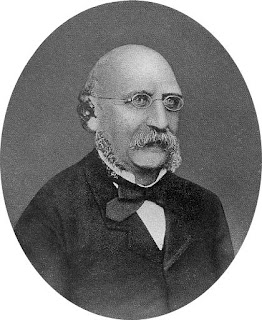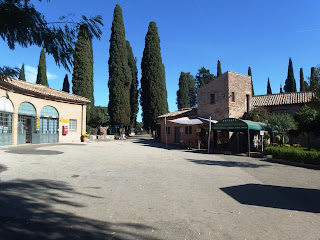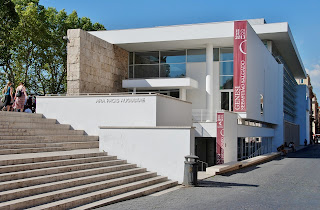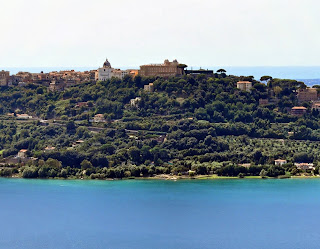Excavations unearthed massive Catacomb of St Callixtus
 |
| Grave niches were carved out of the rock in the passageways of the Roman catacombs |
De Rossi’s most famous discovery – or rediscovery, to be
accurate – of the Catacomb of St Callixtus, thought to have been created in the
2nd century by the future Pope Callixtus I, at that time a deacon of
Rome, under the direction of Pope Zephyrinus, established him as the greatest archaeologist of the 19th century.
The vast underground cemetery, located beneath the Appian
Way about 7km (4.3 miles) south of the centre of Rome, is estimated to have
covered an area of 15 hectares on five levels, with around 20km (12.5 miles) of
passageways.
It may have contained up to half a million corpses,
including those of 16 popes and 50 Christian martyrs, from Pope Anicetus, who
died in 166, to Damasus I, who was pontiff until 384. Nine of the popes were buried in a papal crypt.
 |
| The archaeologist Giovanni Battista de Rossi |
De Rossi, however, whose fascination with Rome’s underground
history had begun when he was a boy, felt their whereabouts needed to be known.
He devoted his life to expanding his knowledge, assembling a
network of friends and contacts among archaeologists and museum curators across
Europe to collate everything that was known from ancient discoveries and ultimately
identified the probable location of several catacombs.
In 1849, he was given permission to tramp round a vineyard
off the Appian Way, where he found a broken marble slab bearing an incomplete
inscription “NELIUS. MARTYR”. Aware from his research that Pope St. Cornelius had
been buried in the area he asked the incumbent pope, Pius IX, to buy the vineyard
so that he could begin an excavation.
It was not long before he found the other half of Pope St
Cornelius’s marble tombstone and through a painstaking process over the next
few years De Rossi gradually revealed the wealth of history he had known for so
long was waiting to be found.
 |
| The entrance to the Catacomb of St Callixtus as it is today |
His interest in Roman history, and in particular of what lay
beneath the ground, had been piqued at an early age, his father giving him a
copy of Antonio Bosio’s vast history, La Roma Sotterranea - Underground Rome - for his 11th
birthday. As a teenager, he befriended Giuseppe Marchi, the city’s Superintendent
of Sacred Relics and Cemeteries.
Marchi, who showed him inside one of the catacombs – of which
there are thought to have been at least 40 around the city – taught De Rossi
the value of studying archaeological finds in situ rather than removing them,
so as not to lose sight of their context.
In his career, De Rossi also explored the catacombs of
Praetextus, Thrason and Priscilla.
 |
| A plate from De Rossi's book shows a reconstruction of the Crypt of the Popes |
Among his other discoveries was the Codex Amiatinus, the earliest
surviving manuscript of the complete Bible in the Latin Vulgate version. He
also made a substantial contribution to the literature of archaeological study.
He produced a four-volume work, of which the final
manuscript was completed just before he died, entitled La Roma Sotterranea
Cristiana, which was an updated Christian version of Bosio’s masterpiece that
he had found so inspiring as a boy, and left details of much of his work to
posterity in the regularly updated Bulletino di archeologia cristiana.
De Rossi died in 1894 at Castel Gandolfo, one of the
Castelli Romani in the Alban Hills south of Rome, and where a summer residence
allowed the popes to escape the city during the oppressively hot months of July
and August.
The Campo Marzio area of Rome, where De Rossi grew up, is a
small section of the 4th Rione of the city, extending roughly from
the Palazzo del Quirinale to the Piazza del Popolo, and bordering the Tiber
river. Among other buildings, it is the
home of something rare in the historic centre of the city – a modern edifice.
The Museum of the Ara Pacis was built in glass, travertine and steel to house
the 1st century Ara Pacis of Augustus, a Roman altar dedicated to Pax,
the goddess of peace, that was discovered under 13 metres of silt before being
result in its present location in 1938.
The museum, which replaced a structure built to protect the arch in the
Fascist era, was designed by the American architect Richard Meier.
Castel Gandolfo, which overlooks Lago Albano from its
wonderful position in the hills south of Rome, is one of the towns within the
regional park of the Castelli Romani. It owes its fame to being the home of an Apostolic
Palace, built in the 17th century by Carlo Maderno on behalf of Urban
VIII, that was traditionally the incumbent pope’s summer residence, with
commanding views over the lake. The palace ceased to be a papal residence in
2016 at the behest of Pope Francis, and visitors can now go inside and enjoy a
guided tour of the papal apartments and grand reception rooms.
Hotels in Castel Gandolfo from Booking.com
More reading:
Giuseppe Fiorelli - the archaeologist who saved Pompeii
Edward Gibbon's moment of inspiration
The Vesuvius eruption of AD79
Hotels in Castel Gandolfo from Booking.com
More reading:
Giuseppe Fiorelli - the archaeologist who saved Pompeii
Edward Gibbon's moment of inspiration
The Vesuvius eruption of AD79
Books:
The Roman Catacombs: A History of the Christian City Beneath Pagan Rome
The Roman Catacombs: The History and Legacy of Ancient Rome’s Most Famous Burial Grounds
(Picture credits: Catacomb by GerardM; via Wikimedia Commons)

